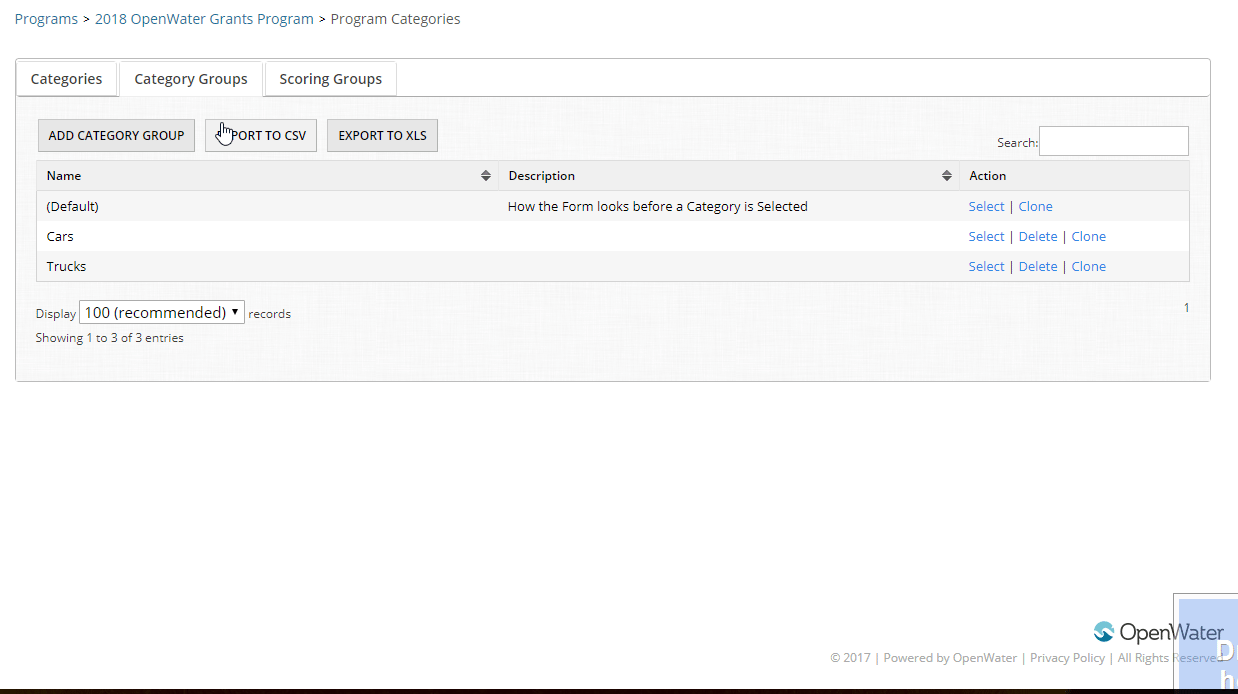What is this feature?
If you do not use the categories feature in OpenWater, you can skip this.
If you ask the same question to the applicant regardless of which category they have chosen, you can also skip this.
If you have a different set of submission form questions depending on which category the applicant chose, then you've come to the right help article.
For each category that you have that contains its own set of questions, the more work you will have in setting up the submission form. If you haven't revisited your questions that you ask your applicants in some time, this might be a good opportunity to standardize. Try and define a submission form that encapsulates as many categories as possible, or larger groups of categories. Hence, this feature is known in OpenWater as Category Groups.
Walking through an example
To illustrate how this works, we are going to use our fictional example of a program that takes in submissions to Cars and Truck categories. The following is our category structure:
If the applicant chooses a Car category we will ask the applicant if the car is a front wheel drive, rear wheel drive, or all wheel drive. However, if the applicant chooses a Truck category, we ask how many wheels the truck has. Let's see how this functions to the end user:
Configuring the Category Groups
Set your questions up
First add all of the questions that you need to ask on the submission form and configure the questions. Below you can see we have both the car and truck questions together on the submission form.
Add and assign your category groups
To add your Category Groups, first navigate to your program.
Under the Program Settings drop down menu, click Category Groups.
Click Add Category Group to add your new group. If every category has its own set of questions, you will need to add a category group for each category.
After your category groups have been added, tab over to the Categories and assign each category to a category group by clicking Select. Choose the category group from the drop down menu and click Save.
The Default Category Group
Return to the list of category groups. You will find at the top a group called (Default). This group is how the form will appear prior to any category being selected. If you noticed from our example above, no questions appeared when no category was chosen. Here it is again:
The questions do not appear because we have chosen to hide them until a category is selected. Click Select on your (Default) group and click Settings tab.
For the questions that are category dependent, we have changed their value in the drop down menu to Hidden. Also note that if your form has multiple pages, the drop down in the upper center of the screen allows you to switch between the pages on your form. If you hide every single question on a page, the entire page will not appear until a category is chosen.
Don't forget to click Save.
The Main Category Groups
There are two ways to configure the main category groups. The primary method is while you are setting up the actual question on the submission form. The other way is through the category group itself. We'll show both approaches now and you can decide which is more convenient for you.
Via the Submission Form Question
First, load up your submission form builder. Choose the submission question you want to configure. Then click Configure Category Group Settings.
If a user chooses a Truck category, we want to hide any non-Truck category questions. Therefore, we hide the question asking how many wheels the truck has, like so:
Click Save and Return to Form. Repeat the process of hiding fields from category groups for each question. If a question always appears for each category, then you do not need to configure its category group settings.
Via the Category Group
Load up the category group you want to configure which questions will show up for and click Select.
If a user chooses a Car category, we want to hide any non-Car category questions. Therefore, we hide the question asking how many wheels the truck has, like so:
We click Save and open up the Truck category group. For this group, we want to hide the non-Truck questions when a user chooses a Truck category. And so we hide the question 'This car is...'.
And that's it! For each category group you have to hide the questions that are not to be shown when that category is chosen. Once you get the hang of it, it is quite simple, but it can be time consuming.
Default vs. Hidden vs. Required vs. Not Required
You may have noticed that there are more than just the Hidden option in the drop down menu. A field in OpenWater can be Required or Not Required. Here's a reminder:
If you choose Default in the drop down menu for a field setting in Category Groups, you are effectively saying, show this field and leave its required status as what is currently set on that field on the submission form. However, you may run into cases where you need to override this. For example, maybe a field is required for some set of categories, but not required for another set of categories. You can override the default setting of the field by choosing Required or Not Required as needed.















